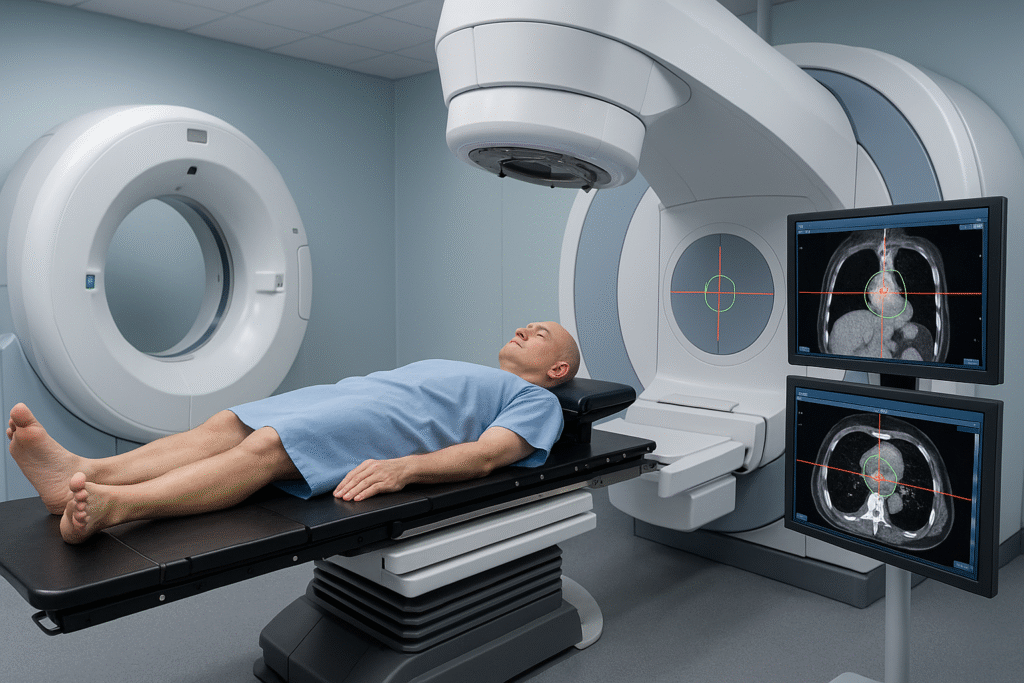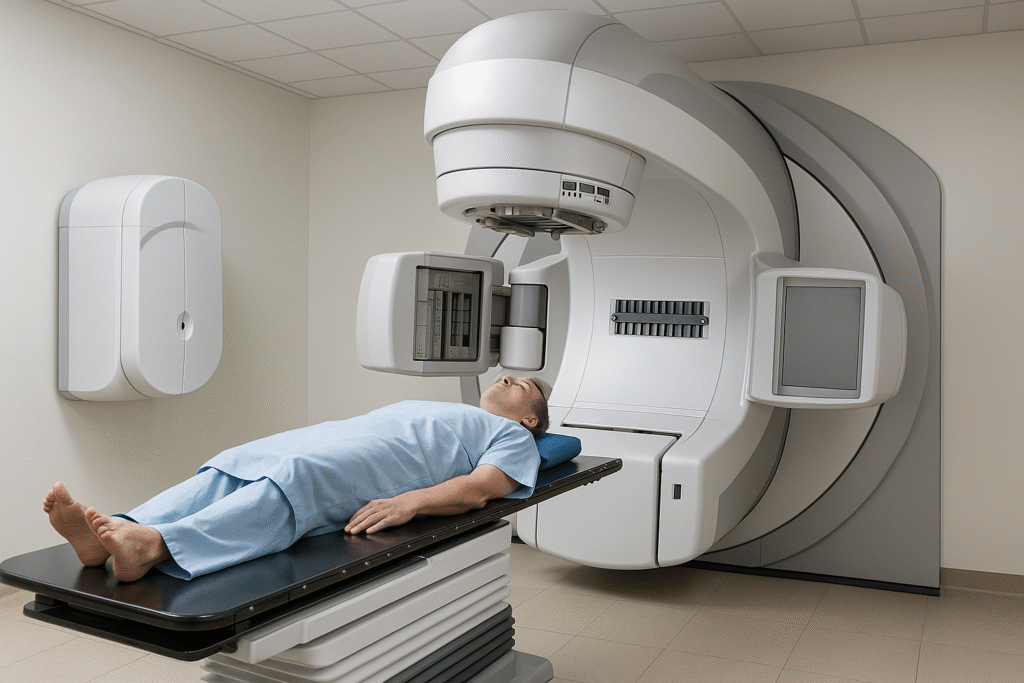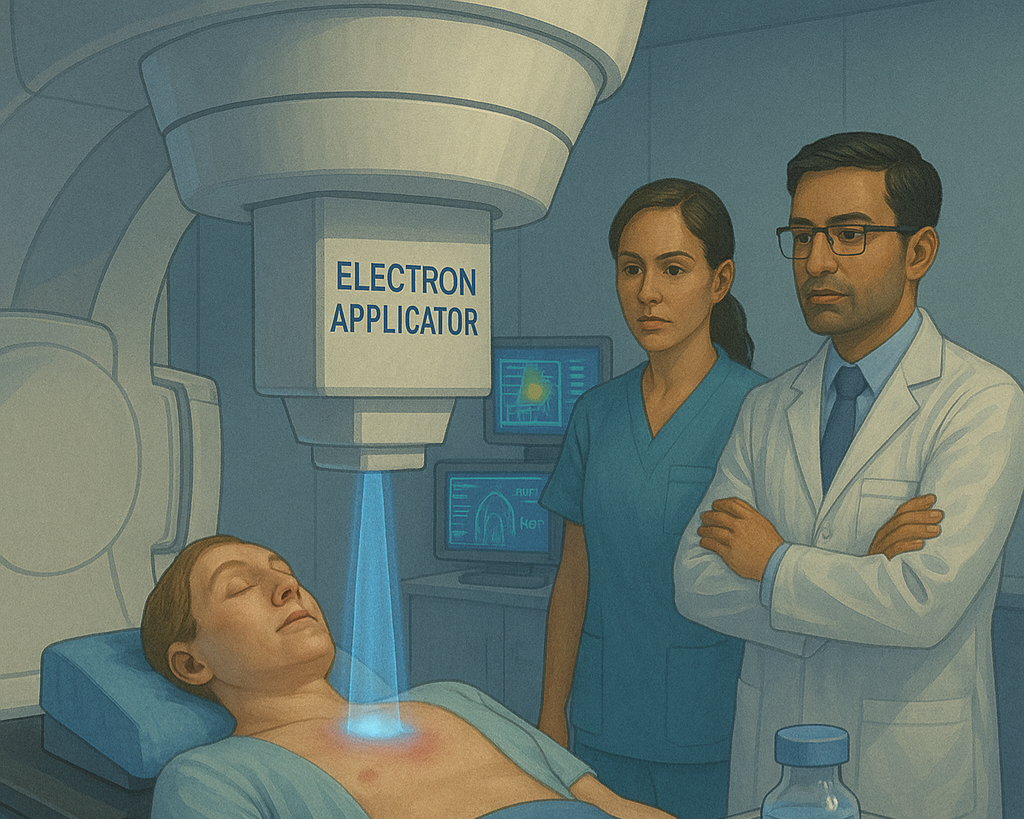Radiotherapy

Image-Guided Radiation Therapy (IGRT)
IGRT is a technique that
combines imaging and radiation therapy to improve treatment
accuracy. Before or during each treatment session, imaging tools
such as cone-beam CT, ultrasound, or X-rays are used to visualize
the tumor and surrounding anatomy in real time. This helps
clinicians adjust the patient’s position or modify the treatment
plan to account for tumor movement due to breathing, bladder
f
illing, or other bodily changes. IGRT is particularly useful in
treating tumors in areas prone to movement, like the lungs or
prostate, and enhances the safety and precision of radiation
delivery.

Intensity-Modulated Radiation Therapy (IMRT)
IMRT is a highly
precise form of external beam radiotherapy that allows the radiation
dose to be shaped to match the three-dimensional shape of the
tumor. Using computer-controlled linear accelerators, IMRT delivers
multiple small beams of varying intensities from different angles. This
approach allows higher doses to the tumor while sparing surrounding
healthy tissues and critical organs. IMRT is especially beneficial in
complex-shaped tumors located near sensitive structures, such as in
head and neck cancers, prostate cancer, and gynecological
malignancies.

Volumetric Modulated Arc Therapy (VMAT)
VMAT is an advanced
form of IMRT that delivers radiation in a continuous arc around the
patient, rather than from fixed angles. The radiation dose rate, the
shape of the beam, and the speed of rotation are all dynamically
adjusted during the treatment. This results in faster treatment times
compared to traditional IMRT, often delivering a precise dose in just a
few minutes. VMAT is ideal for treating large or complex tumors
efficiently while maintaining high conformality and sparing nearby
organs.

3D Conformal Radiation Therapy (3DCRT)
3DCRT is a technique
that uses three-dimensional imaging (such as CT or MRI) to map the
size, shape, and location of a tumor. Based on this information,
radiation beams are shaped to match the exact contours of the tumor
from several angles. Though less complex than IMRT or VMAT, 3DCRT
provides a significant improvement over conventional two
dimensional radiotherapy by allowing better targeting and reducing
dose to surrounding normal tissues. It is widely used in many
common cancers, including breast, lung, and brain tumors.

Electron Therapy
Electron therapy uses high-energy electron
beams instead of X-rays to treat superficial tumors. Electrons have a
limited penetration depth, making this technique ideal for cancers
and lesions located close to the skin surface, such as skin cancers,
chest wall recurrences after mastectomy, or superficial lymph nodes.
One of its key advantages is that the radiation dose drops off quickly
beyond the target area, minimizing damage to deeper tissues.
Electron therapy is simple, effective, and often delivered over several
sessions, depending on the tumor type and location.

Brachytherapy
Brachytherapy is a form of internal radiotherapy
where a radioactive source is placed directly inside or next to the
tumor. This allows for a high dose of radiation to be delivered
precisely to the cancer while minimizing exposure to surrounding
healthy tissues. It is commonly used for cancers of the cervix,
prostate, breast, and oral cavity. Brachytherapy can be delivered as
low-dose-rate (LDR) or high-dose-rate (HDR), depending on the
clinical need. The treatment may be temporary or permanent, and is
often used in combination with external beam radiotherapy for better
tumor control.

Stereotactic Radiosurgery (SRS)
SRS is a non-surgical radiation
therapy used primarily to treat small tumors in the brain or spine with
extreme precision. It delivers a very high dose of radiation in a single
session or a few sessions (usually 1–5), using multiple focused beams
that converge on the tumor. Advanced imaging and immobilization
techniques ensure sub-millimeter accuracy. Despite its name, SRS is
not actual surgery—there’s no incision involved. It is highly effective
for brain metastases, arteriovenous malformations, and benign brain
tumors like acoustic neuromas or meningiomas.

Stereotactic Body Radiation Therapy (SBRT)
SBRT extends the
principles of SRS to treat tumors outside the brain, such as those in
the lungs, liver, pancreas, adrenal glands, and spine. Like SRS, SBRT
delivers high doses of radiation in 1 to 5 sessions with pinpoint
accuracy, allowing for excellent tumor control with minimal exposure
to surrounding tissues. It’s especially beneficial for patients who are
not surgical candidates or when tumors are located near sensitive
structures. SBRT requires precise imaging and motion management
(such as respiratory gating) to track tumor movement during
treatment.
Posted onTrustindex verifies that the original source of the review is Google. The best oncology of odisha thank you sir for treatment my mother breast cancer journey. Thank you sir for being with us.Posted onTrustindex verifies that the original source of the review is Google. I am incredibly grateful to Dr.Abani kanta Nanda,the best oncology doctor in odisha, for his exceptional care and expertise.I was undergoing radiotherapy for rectal cancer, and Dr.nanda and his team provided not only the best treatment but also immense support throughout the process.his compassionate approach and in-depth knowledge gave me confidence and comfort during a challenging time.I highly recommend him to anyone seeking world-class cancer treatment.thank you,Dr.nanda, for your dedication and kindness!🙏🙏🙏Posted onTrustindex verifies that the original source of the review is Google. I have faced many doctors in my life,but Dr.Abani Kanta Nanda is the best among them.He is so polite and so simple.His treatment for cancer is quite brilliant.I never feel that he is my doctor.rather I feel him as my family member.I pray to God that Dr Abani Kant Nanda achieve great success in his life.Posted onTrustindex verifies that the original source of the review is Google. Very good doctor!! Very Well manner and listen everything peacefully each and every problem of patient!! Best treatment and patient friendly!!Posted onTrustindex verifies that the original source of the review is Google. Best doctor.my experience is good . Ritanjali Rout.Posted onTrustindex verifies that the original source of the review is Google. ❤️Posted onTrustindex verifies that the original source of the review is Google. Dr. Abani Kanta Nanda is an outstanding healthcare professional who excels in both knowledge and patient care. From the moment you walk into his cabin , you can sense his commitment to excellence. He has an impressive depth of knowledge and stay up - to- date with the latest advancements in his field , which will give you confidence that you're receiving the best possible care . Highly recommending! 🙌

Get In Touch!
Dr. Abani Kanta Nanda: Best Oncologist In India

Dr. Nanda holds an MBBS and MD in Radiation Oncology from S.C.B. Medical College and Hospital, Cuttack, with advanced training and over five years of post-doctoral experience at the prestigious Acharya Harihar Post Graduate Institute of Cancer (AHPGIC).
Get In Touch
- Patho Care Clinic, Near UCO Bank ATM, Kathagolasahi, Mangalabag, Cuttack, Odisha Pin- 753001
- (+91) 9861 911 213
- drabaninanda@gmail.com
Copyright © 2025 www.drabanikantananda.com | Designed by Rnd Digital – All Rights Reserved.

